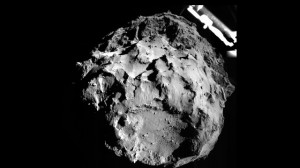Rosetta Mission’s Probe Makes Historic Comet Landing
< < Go Back
European Space Agency’s Philae Is First Craft to Land on Comet in Historic Moment for Space Exploration.
A robotic probe has landed on a comet, in an unprecedented moment for space exploration that could provide a trove of insights into what comets are made of and how they behave.
Rocket scientists at the European Space Agency’s mission control here erupted in cheers, as they received the first signal that the probe that was released from the Rosetta spacecraft had touched down more than 300 million miles away from earth on the forbidding landscape of a small comet known as 67P/Churyumov-Gerasimenko.
There were even more cheers, hugs and handshakes when other signals suggested it had done so safely.
The landing, first envisaged more than 20 years ago, marks the crowning moment of Rosetta’s decadelong cruise through the solar system to get up close and personal with a comet. During its 4 billion mile journey on a track to meet the comet, Rosetta bounced around the inner solar system like a cosmic billiard ball, circling the sun almost four times.
The landing wasn’t without hitches. The comet’s gravity is thousands of times weaker than that of earth. A thruster aboard the probe that should have helped anchor the lander to the comet couldn’t be switched on Tuesday night, and harpoons meant to lock the probe onto the surface didn’t fire. As a result, it appeared the probe, called Philae, may have bounced off the surface before settling back.
Nonetheless, Philae appears to have settled on its three legs in the center of the target zone, a relatively flat elliptical landing area about 550 yards in diameter, away from deep crevices, large boulders and sharp peaks.
The mission has already hit several milestones. Rosetta is the first craft to settle into close orbit around a comet and the first to land a probe onto one. As it continues its travels, it is expected to also become the first spacecraft to accompany a comet as it loops around the sun.
During its descent, Philae snapped a picture while just about 2 miles from the comet’s surface. More dramatic pictures taken from the comet’s surface are expected to be received on Thursday. It takes nearly half an hour for a signal from the comet to reach earth.
Made of ancient ice, dust and other materials, comets are objects of scientific curiosity because they have survived virtually intact from the earliest days of the solar system, more than 4.5 billion years ago. Studying them can provide clues about how the solar system formed and evolved.
Because comets carry water and organic molecules, scientists also hope that the Rosetta mission will provide insights into whether comets could have brought water to Earth and possibly kick-started life here.
More From The Wall Street Journal (subscription required):




